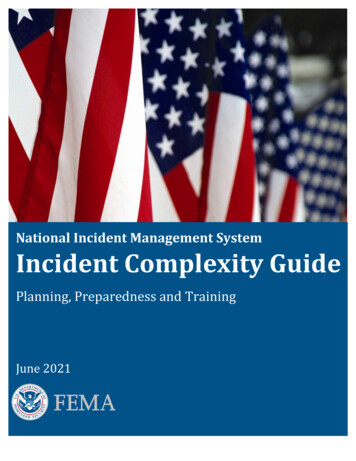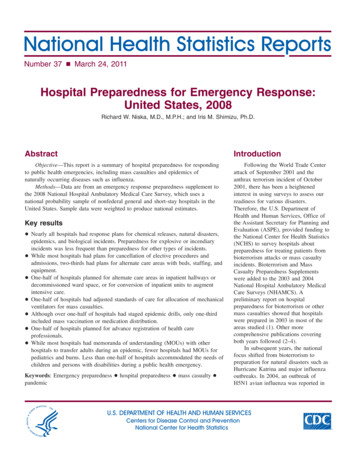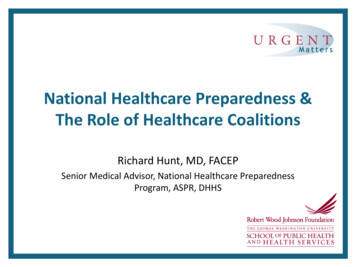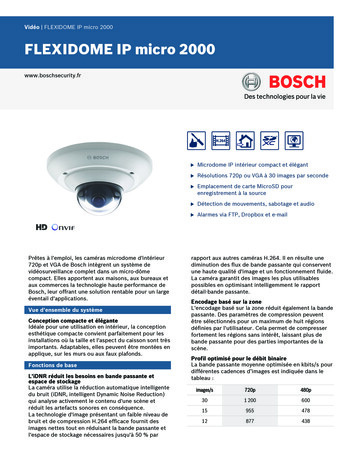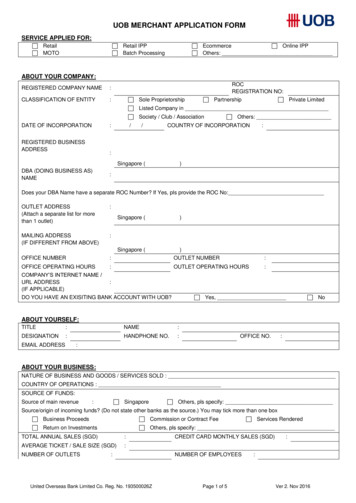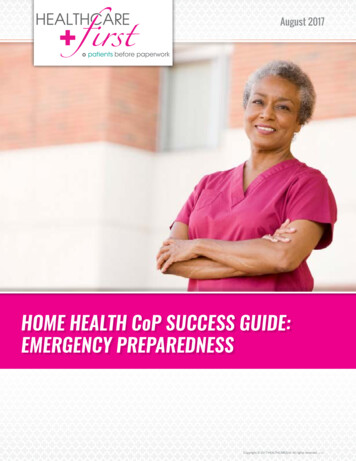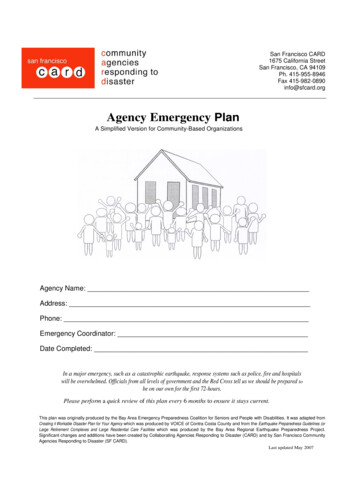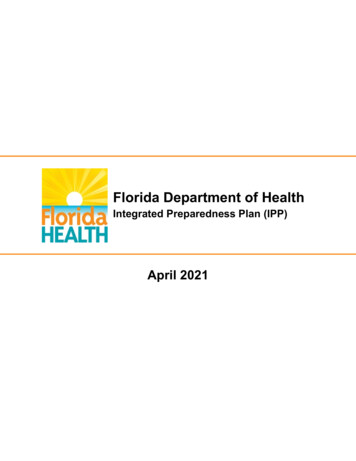
Transcription
Florida Department of HealthIntegrated Preparedness Plan (IPP)April 2021
Florida Department of HealthBureau of Preparedness and ResponseIntegrated Preparedness Plan (IPP)Table of ContentsPreface .3Points of Contact (POCs) .4Purpose .5Hazard Focus Areas.62021 Integrated Preparedness Plan Workshop (IPPW) Process .8Training Development Priorities . 8Tabletop (TTX) Exercise Development Priorities . 82022 IPPW Process Projection. 9Methodology and Tracking. 9Appendix A: Florida Health Care Coalitions .10Appendix B: Acronym Guide.112 Page
Florida Department of HealthBureau of Preparedness and ResponseIntegrated Preparedness Plan (IPP)PrefaceThe Florida Division of Emergency Management (FDEM) is responsible for developing andmaintaining the state of Florida Integrated Preparedness Plan (IPP), formerly known as theMulti-Year Training and Exercise Plan (MYTEP).The state of Florida’s IPP document representsall domestic security interdisciplinary training and exercise (T & E) goals and projectedschedules for the state and is updated annually. The Florida Department of Health’s (FDOH),Bureau of Preparedness and Response (BPR), uses a capability-based approach in relation tothe preparedness cycle. Preparedness is a continuous cycle of planning, organizing, training,equipping, exercising, evaluating, and taking corrective action, to ensure effective coordinationduring incident response. Due to COVID-19, collaboration efforts were limited, with only HealthCare Coalitions, and not County Health Departments, in creating the 2022-2024 IPP.FDEM uses a standard collection process that allows for input from both county and statestakeholders, including the Department of Health. The state of Florida’s IPP provides a roadmapfor Florida to accomplish priorities described in Florida’s Domestic Security Strategic Plan. Eachstate priority is linked to a corresponding national priority and, if applicable, an improvementplan. The priority is further linked to associated federal capabilities, as well as training andexercises to help jurisdictions achieve those capabilities.The Department of Health’s HCCs and CHDs create the Florida Department of Health’s annualIPP. The documented is updated every year and follows a similar collection process used byFDEM. The IPP is published and submitted to FDEM for inclusion in the state of Florida IPP. Italso provides a framework for training and exercise priorities to meet goals, objectives, andstrategies in the Department’s strategic plan.The goal of Florida’s IPP is to help prevent and/or minimize illness, injury, and loss of life toFloridians and visitors due to person-made or natural disasters, or other emergencies. TheDepartment achieves this goal through developing and sustaining critical capabilities whichenhance the ability of Florida’s public health and health care system to prevent, respond to, andrecover from all types of hazards. Having a viable public health and health care system is part ofan integrated domestic security and emergency management system in Florida.The Department of Health’s IPP aligns with the 2017-2022 Health Care Preparedness andResponse Capabilities, Office of the Assistant Secretary for Preparedness and Response(ASPR), as well as the Centers for Disease Control and Prevention (CDC) Public HealthEmergency Preparedness and Response Capabilities: National Standards for State and LocalReadiness, where each capability standard identifies resource elements pertinent to bothroutine general public health activities and critical public health services. This helps support an“everyday use” model in which applying the capability standards improves day-to-dayeffectiveness in building a stronger foundation.For additional information on the IPP and/or any of its components, please contact Zuzel Alonsoat Zuzel.Alonso@flhealth.gov or 850-245-4894.3 Page
Florida Department of HealthBureau of Preparedness and ResponseIntegrated Preparedness Plan (IPP)Points of Contact (POCs)Training and Exercise Section Program Manager:Bobby Bailey, Paramedic, BS (Retired May 2021)Bureau of Preparedness and ResponseFlorida Department of Health4052 Bald Cypress Way, Bin A23Tallahassee, Florida 32399Training Unit Program Manager:Ann RoweBureau of Preparedness and ResponseFlorida Department of Health4052 Bald Cypress Way, Bin A23Tallahassee, Florida 32399850-617-1541 (office)850-274-6658 (cell)Ann.Rowe@flhealth.govExercise Unit Program Manager/Interim Trainingand Exercise Section Program Manager:Debbie KelleyBureau of Preparedness and ResponseFlorida Department of Health4052 Bald Cypress Way, Bin A23Tallahassee, Florida 32399850-617-1521 (office)850-528-7672 (cell)Debbie.Kelley@flhealth.govIPP Coordinator:Zuzel Alonso, MPHBureau of Preparedness and ResponseFlorida Department of Health4052 Bald Cypress Way, Bin A23Tallahassee, Florida 32399850-245-4894 (office)772-579-8520 (cell)Zuzel.Alonso@flhealth.gov4 Page
Florida Department of HealthBureau of Preparedness and ResponseIntegrated Preparedness Plan (IPP)PurposeThe purpose of the 2022-2024 PHHP IPP is to provide training and exercise priorities and aroadmap to meet strategies to support the following national and state standards: Public Health Emergency Preparedness and Response Capabilities: NationalStandards for State and Local Planning (October 2018; Updated January 2019) ASPR Health Care Preparedness Capabilities, 2017-2022 Health CarePreparedness and Response Capabilities (November 2016) After-Action Report/Improvement Plan (AAR/IP) data from Florida statewideexercises and real-world emergency incidents and events The Department’s Appendix to the State’s Comprehensive EmergencyManagement Plan (CEMP) FDOH Strategic Priorities for Preparedness Activities, July 2017 – June 2022;Developing and sustaining public health and health care capabilities enhances BPRs ability toprevent, respond to, and recover from disasters and emergencies of all types. In this way, theDepartment ensures coordination across the spectrum of capabilities, which allows for aresilient, flexible, and adaptable public health and health care preparedness system.The IPP covers training and exercise priorities that are both common across the entire state andjurisdictionally specific. In addition, the public health and health care community is encouragedto participate in their county emergency management IPP process, leverage their local Threatand Hazard Identification and Risk Assessment (THIRA) and Florida Public Health RiskAssessment Tool (FPHRAT), and After-Action Plans (AAR) when addressing gaps. Thisensures their community priorities are addressed.Each year, county health departments (CHDs), and health care coalitions (HCCs) strive toachieve IPP goals. IPP priorities listed in the 2022-2024 templates and calendars are guidelinesto reach the targets identified in local strategies as well as in the FDOH Strategic Priorities forPreparedness Activities. Due to COVID-19, County Health Departments were engaged invaccination efforts and therefore not able to participate during this (2020-2021) cycle.The FDEM’s annual Statewide Exercise provides a unique opportunity for all Department ofHealth programs with response or support responsibilities, to test capabilities with stateEmergency Support Function 8 (ESF-8), HCCs, and local partners.The Department uses the Homeland Security Exercise and Evaluation Program (HSEEP) as thestandard for exercise management. Adherence to the guidance presented in the HSEEPmethodology ensures exercise programs conform to established best practices and helpsprovide unity and consistency in exercises for all levels of government and non-governmentalpartners.5 Page
Florida Department of HealthBureau of Preparedness and ResponseIntegrated Preparedness Plan (IPP)Hazard Focus AreasThe Department’s Preparedness Strategic Planning Oversight Team (SPOT) identified five (5)hazard types as the priority focus areas for alignment of preparedness activities (shown below).The hazard focus areas change periodically, and during a five-year grant funding period,generally work effort should be aligned with and in support of building capability to respond tothese specific hazard types. Additionally, preparedness efforts would be measured per thesehazard types to determine if the residual risk to these hazards decreases as capability andresources increase.Hazard mHazard NameHurricane /TropicalStorm* /SevereWeatherDefinitionThe occurrence of a larger number of cases of an illness or syndrome thanexpected in a certain location during a certain (usually short) timeframe. Thisdefinition also includes those biological agents found in the environmentand/or diagnosed in animals. Biological disease outbreaks include zoonoticdisease(s) and/or an increase in the population of disease‐carrying speciesthat have the potential for transmission to humans, including vectors ofvector‐borne illnesses.* This hazard serves as an overarching category for other hazards withsimilar public health and medical response activities to include BiologicalTerrorism – Communicable, Biological Terrorism - Non-Communicable andPandemic Influenza. Biological Disease Outbreak will be the hazardmeasured as a proxy for all these hazard types.The unlawful use of force and violence against persons or property tointimidate or coerce a government, the civilian population, or any segmentthereof, in furtherance of political and/or social objectives. May also includeattempted or suspected terrorist intentions that have been successfullythwarted through investigative activity. For the purposes of this analysis,conventional terrorism includes all terrorism except agricultural, biological,chemical, or radiological terrorism which are covered in other hazards in thisanalysis.DefinitionA low-pressure area of closed circulation winds that originates over tropicalwaters. When sustained wind speeds exceed 39 miles-per-hour (mph), theyare called tropical storms; when wind speeds exceed 74 mph, they are calledhurricanes.* This specific hazard serves as an overarching category for other hazardswith similar public health and medical response activities, to include StormSurge. Hurricane/Tropical Storm will be the hazard measured as a proxy forboth hazard types.Severe weather refers to any dangerous meteorological phenomena with thepotential to cause damage, loss of power, serious social disruption, or loss ofhuman life. Types of severe weather phenomena vary, depending on thelatitude, altitude, topography, and atmospheric conditions.6 Page
Florida Department of HealthBureau of Preparedness and ResponseIntegrated Preparedness Plan (IPP)Hazard NameDefinitionMassCasualtyIncidentsAn incident that generates a sufficiently large number of casualties, wherebythe available health care resources or their management systems areseverely challenged or unable to meet the health care needs of the affectedpopulation.MassPopulationSurgeThe population of an area is increased, due to a migration/ relocation ofanother community.7 Page
Florida Department of HealthBureau of Preparedness and ResponseIntegrated Preparedness Plan (IPP)2021 Integrated Preparedness Plan Workshop (IPPW) ProcessWe were unable to conduct an in-person Integrated Preparedness Plan Workshop (IPPW), due to activation ofBPR, HCC, and CHD staff in responding to the novel Coronavirus disease (COVID-19) Pandemic. Whileactivation for COVID-19 began on February 27, 2020, it is currently ongoing as of April 30, 2021. Hence in theabsence of CHD participation, the 2022-2024 IPP reflects HCC training and exercise needs.Throughout the IPP/IPPW process, virtual meetings were held with the HCCs, including a final meeting tocomplete each of their 2022-2024 IPP submissions. These individual meetings were conducted via onlineZoom or Microsoft Teams technology. The purpose of each was to determine training and exercise gaps,identify current and projected priorities, as well as discuss inputs to their 2022-2024 IPP. An online survey viaSurvey Monkey was sent to HCC voting representatives to determine their top three training and tabletopexercise entries to be developed by T&E for Fiscal Year 2021-2022.We identified training and exercise needs among the seven (7) regions, with input from all 10 HCCs. Afterreceiving all suggestions, the HCCs were asked through an online survey to pick their top three (3) training andtop three (3) tabletop (TTX) exercises from an integrated list.Training Development PrioritiesThe top three (3) trainings are listed below with their associated capability and priority.The Bureau of Preparedness and Response (BPR), T&E Section will develop these during the 2021-2022grant cycle:Health Care CoalitionsCapabilityPriorityTraining Priority #1: Medical SurgePediatric Surge (All Hazards)Training Priority #2: Medical SurgeBurn TrainingTraining Priority #3:Responder Safety and HealthMental Health Resilience Training for theHealthcare & Public Health SectorsTabletop (TTX) Exercise Development PrioritiesThe top three (3) TTX are listed below with their associated capability and priority.The BPR, T&E Section will develop these during the 2021-2022 grant cycle.Health Care Coalitions8 PageCapabilityPriorityTTX Priority #1: Medical SurgeBurn TTXTTX Priority #2: Medical SurgeChemical/Radiation TTXTTX Priority #3: Medical SurgePediatric Surge TTX
Florida Department of HealthBureau of Preparedness and ResponseIntegrated Preparedness Plan (IPP)2022 IPPW Process ProjectionIn 2022, the FDOH and FDEM will work together towards next year’s regional Integrated Preparedness Plan(IPP), to ensure preparedness activities are built into training and exercise plans. This will allow stakeholdersto have a more comprehensive understanding of their capabilities, as well as develop a whole communityapproach to ever-changing threats, hazards, and risks in their regions.Methodology and TrackingStrategies for supporting 2022-2024 training and exercise needs:1) Engage HCC’s in identifying training and exercise needs for the health care workforce.2) Coordinate with HCC’s to develop, review, approve, deliver, and evaluate training and exercises forthe health care workforce.3) Manage a system for training and exercise activities.Additional DetailsFor additional information about the Department’s training, exercise, and evaluation system, -response/training-exercise/index.html9 Page
Florida Department of HealthBureau of Preparedness and ResponseIntegrated Preparedness Plan (IPP)Appendix A: Florida Health Care Coalitions10 P a g e
Florida Department of HealthBureau of Preparedness and ResponseIntegrated Preparedness Plan (IPP)Appendix B: Acronym GuideAARAfter-Action ReportACSAlternate Care SitesAHIMTAll Hazards Incident Management TeamAMLSAdvanced Medical Life SupportASPRAssistant Secretary for Preparedness and ResponseBDLSBasic Disaster Life SupportB-FASTBasic Disaster Behavioral Health First Aid SpecialistTrainingC-FASTDisaster Behavioral Health First Aid Specialist Trainingfor ChildrenBPRBureau of Preparedness and ResponseCBRNEChemical, Biological, Radiological, Nuclear & ExplosiveCDCCenters for Disease Control and PreventionCDPCenter for Domestic Preparedness, Anniston, ALCOOPContinuity of Operations PlanningDECONDecontaminationDOHDepartment of HealthEHEnvironmental HealthEMEmergency ManagementEMSEmergency Medical ServicesEOCEmergency Operations CenterER/EDEmergency Room/Emergency DepartmentESFEmergency Support Function11 P a g e
Florida Department of HealthBureau of Preparedness and ResponseIntegrated Preparedness Plan (IPP)FASTFirst Aid Specialist Training for [Disaster] BehavioralHealthFDOHFlorida Department of HealthFEMAFederal Emergency Management AgencyFEMORSFlorida Emergency Mortuary Operations ResponseSystemFEFunctional ExerciseFHAFlorida Hospital AssociationFIDTNFlorida Infectious Disease Transportation NetworkFDEMFlorida Division of Emergency ManagementFPHRATFlorida Public Health Risk Management Assessment ToolFSEFull Scale ExerciseGHCGovernor’s Hurricane ConferenceHCHealth CareHCCHealth Care CoalitionHERCHealthcare Emergency Response CoalitionHICSHospital Incident Command SystemHPPHospital Preparedness ProgramHSEEPHomeland Security Exercise and Evaluation ProgramHVAHazard and Vulnerability AnalysisIAPIncident Action PlanICSIncident Command SystemIMSSIncident Management System Software (PatientManagement, Patient Tracking)IMTIncident Management Team12 P a g e
Florida Department of HealthBureau of Preparedness and ResponseIntegrated Preparedness Plan (IPP)IPImprovement PlanIPPIntegrated Preparedness PlanIPPWIntegrated Preparedness Plan WorkshopIRMSInventory Resource Management SystemITInformation TechnologyJICJoint Information CenterJISJoint Information SystemMCIMass Casualty IncidentMRCMedical Reserve CorpsMYTEPMulti-Year Training and Exercise PlanNHICSNursing Home Incident Command SystemNIMSNational Incident Management SystemNPPNuclear Power PlantNWSNational Weather ServicePHPublic HealthPHEPPublic Health Emergency PreparednessPIOPublic Information OfficerPODPoint of Dispensing/Point of DistributionR (1-7)Domestic Security Task Force Region designated bynumberRADRadiologicalRDSTFRegional Domestic Security Task ForceR-FASTDisaster Behavioral Health First Aid Specialist Trainingfor Responders13 P a g e
Florida Department of HealthBureau of Preparedness and ResponseIntegrated Preparedness Plan (IPP)RSSReceipt, Stage, and StoreRTIPPReadiness: Training, Identification, Preparedness,PlanningSNSStrategic National StockpileSpNSSpecial Needs ShelterSPOTStrategic Planning Oversight TeamSTStrike TeamT&ETraining and Exercise SectionTEPWTraining and Exercise Planning WorkshopTHIRAThreat and Hazard Identification and Risk AssessmentTTXTabletop ExerciseV-JICVirtual Joint Information CenterWBTWeb-Based Training14 P a g e
Integrated Preparedness Plan: Training Schedule 2022OrganizationEmerald CoastHealth CareCoalition: Region 1JanFebMarAprMayJunJulAugSepOctNovDecICS-300 IntermediateIncident Command Systemfor Expanding IncidentsFDOH SpNS: RefresherNursing Skills LiteFDOH SpNS: RefresherNursing Skills LiteInfectious SubstancesPackaging and ShippingTrainingESF-8 Bootcamp TrainingL-950: All-Hazards PositionSpecific IncidentCommanderL-956 All-Hazards PositionSpecific Liaison OfficerICS-400 Advanced IncidentCommand System forCommand and General Staff– Complex IncidentsICS-300 IntermediateIncident Command Systemfor Expanding IncidentsMGT-319 Mass ProphylaxisPreparedness & Planning:Medical Countermeasures:Points of Dispensing (POD),Planning, and ResponseFDOH SpNS: RefresherNursing Skills LiteMGT-319 Mass ProphylaxisPreparedness & Planning:Medical Countermeasures:Points of Dispensing (POD),Planning, and ResponsePER-310: Strategic NationalStockpile PreparednessCourseICS-300 IntermediateIncident Command Systemfor Expanding IncidentsG-2300 IntermediateEmergency OperationsCenter FunctionsMGT-347 IncidentCommand System (ICS)Forms ReviewL-962: All-Hazards PositionSpecific Planning SectionChiefE0948: SituationalAwareness and CommonOperating PictureFDOH SpNS: RefresherNursing Skills LiteMGT-319 Mass ProphylaxisPreparedness & Planning:Medical Countermeasures:Points of Dispensing (POD),Planning, and ResponseL-964 All-Hazards PositionSpecific Situation UnitLeaderMGT-439 Pediatric DisasterResponse EmergencyPreparednessG-386 Mass FatalitiesIncident ResponseG-291 Joint InformationSystem/Center Planning forTribal, State, and LocalPublic Information OfficersL-984 All-Hazards TaskForce/Strike Team LeaderRegional O2 DispensingTrailer TrainingInfectious SubstancesPackaging and ShippingTrainingG-300 Intermediate IncidentCommand System forExpanding IncidentsMGT 416 Introduction toContinuity of GovernmentPlanning for RuralJurisdictionsICS 400 Advanced IncidentCommand System forCommand and General Staff– Complex IncidentsG-290: Basic PublicInformation Officer (PIO)G-300 Intermediate IncidentCommand System forExpanding IncidentsAWR-232 Mass FatalitiesRural CommunityC-FAST: Disaster BehavioralHealth First Aid SpecialistTraining, ChildrenL-984 All-Hazards TaskForce/Strike Team LeaderL-146 HSEEP HomelandSecurity Exercise andEvaluation Program TrainingCourseL-967: NIMS ICS AllHazards Logistics SectionChief (LSC)E0948 SituationalAwareness and CommonOperating PictureL-449 Incident CommandL-954: All-Hazards PositionSystem (ICS) Curricula TrainSpecific Safety Officerthe-Trainer0-305 All Hazards IncidentManagement TeamL-550 Continuity ofOperations Planner'sWorkshopPER-320 PersonalProtective Measures forBiological EventsL-449 Incident CommandSystem (ICS) Curricula Trainthe-TrainerFDOH SpNS: RefresherNursing Skills LiteL-101 Foundations ofEmergency ManagementMGT-341* DisasterPreparedness forHospitals and HealthcareOrganizationswithin the CommunityInfrastructureG-400 Advanced IncidentL-954: All-Hazards PositionCommand System forSpecific Safety OfficerCommand and General Staff– Complex IncidentsPacking and ShippingDivision 6.2 MaterialsActive Shooter TrainingG-141 InstructionalB-FAST: Disaster BehavioralPresentation and Evaluation Health First Aid SpecialistTrainingSkillsMGT-310 Threat and HazardIdentification and RiskAssessment andStakeholder PreparednessReviewL-962: All-Hazards PositionSpecific Planning SectionChiefG-557 Rapid NeedsAssessmentL-958: All-Hazards PositionSpecific Operations SectionChiefAWR-934-V7: HospitalIncident Command SystemBig Bend HealthCare Coalition:Region 2NHICS - Nursing HomeIncident Command SystemICS-300: IntermediateIncident Command Systemfor Expanding IncidentsFDOH SpNS: RefrsherNursing Skills LitePER-321-V1: BarrierPrecautions and ControlsICS-400: Advanced IncidentCommand System forCommand and General Staff– Complex IncidentsL-958: NIMS ICS AllHazards Position SpecificOperations Section Chief(OSC) CourseG-402: Incident CommandSystem, Overview forExecutives and SeniorOfficialsFDOH SpNS: BodyMechanics TrainingUntil Help Arrives - Stop theBleedInfectious SubstancesPackaging and ShippingTrainingFDOH SpNS: Operationsand Management OverviewTrainingFlorida Week at CDPHealthcare LeadershipIMS 650 - JursidictionalCrisis ManageementPER-321-V2: Pathogens ofSpecial ConcernAWR 308 Natural DisasterAwareness for CaregiversPER-321-V3: PatientManagement: Receiving aHighly Infectious DiseasePatientPER-321-V4: PatientManagement: Managementof a Highly InfectiousDisease Patient in aHealthcare FacilityHCEM - HealthcareEmergency ManagementAdult and Pediatric FirstAid/CPR/AED-BLB-FAST: Disaster BehavioralHealth First Aid SpecialistTrainingMGT314 - Enhanced AllHazards IncidentManagementIT COOP workshop with staffCDC1202: EH Training inEmergency ResposeSpNS training gearedtowards logistics supportSpNS training gearedtowards support staffB-FAST: Disaster Behavioral FDOH SpNS: Special NeedsHealth First Aid SpecialistShelter Operations andTrainingManagement OverviewSpNS training gearedtowards medical staffEmergency OxygenAdministrationFDOH SpNS: BodyMechanics TrainingFDOH SpNS: RefresherNursing Skills LiteFDOH SpNS: RefresherNursing Skills LiteTRAINFL ID 1053059(Alternate Care Sites-ModuleII)FDOH SpNS: RefresherNursing Skills LiteFDOH SpNS: BodyMechanics TrainingDisaster Responder Health& Safety refresherC-FAST: Disaster BehavioralHealth First Aid SpecialistTraining, ChildrenMGT 319 MedicalCountermeasures: Point ofDispensing (POD), Planningand ResponseActive Shooter Training(Alice)L-958: All-Hazards Position Active Shooter Hostile EventICS-400: Advanced ICSSpecific Operations Section Response Training (RHFT) Command and General StaffChief(internal training)Complex IncidentsA.L.I.C.E. Refresher
MGT-452: Physical andCybersecurity for CriticalInfrastructureFDOH SpNS: Oxygen inSheltersPFA-L: Psychological FirstAid for LeadersStaff Support in theNursing Home IncidentMGT-442-1: POD EssentialsHealthcare Setting (internalCommand Systems (NHICS)Train-the-Trainertraining)FDOH SpNS: BodyMechanics TrainingMGT-347 IncidentCommand System (ICS)Forms ReviewHealthcare Facility Surgeand Evacuation (internaltraining)Persons with dementia inSpNs settingWebEOC RefresherCrisis Standards of Care inDisaster SituationsNortheast FloridaHealth CareCoalition: Region 3PER 213: Wide Area SearchUS National Grid Training(internal training)Fatality Management atSpNS Shelter/FloridaEmergency MortuaryOperations ResponseSystem (FEMORS)State AmbulanceDeployment Plan (internaltraining)Refresher Hazmat andDecon for Hospital andHealthcare (internal training)Hazmat Operations LevelFirst Receivers (internaltraining)Healthcare Facility Surgeand Evacuation (internaltraining)ICS-300: IntermediateState Patient Movement PlanIncident Command System(internal training)Refresher Hazmat andDecon for Hospital andHealthcare (internal training)Care of Dialysis Patients inNursing Home Incidentspecial needs sheltersCommand Systems (NHICS)Refresher Hazmat andDecon for Hospital andHealthcare (internal training)Shelter ManagementTraining - ARCHurricane Preparedness andPlanning (internal training)Annual Special NeedsSheltering Course andDemonstrationHospital Incident CommandSystems (HICS) - no codebut national courseMGT-319 MedicalCountermeasures: Point of MGT-318: Public InformationDispensing (POD), Planning in an All-Hazards Incidentand ResponseTampa Bay Health& MedicalPreparednessCoalition: Region 4FDOH SpNS: BodyMechanics TrainingFDOH SpNS: RefresherNursing Skills LiteSat Phone Training (800MHz Training)ICS/G-400: AdvancedMGT-319 MedicalMedical Reserve CorpsEPI: Food and Water Borne Incident Command System MGT-319 Bioterrorism: MassCountermeasures: Point ofPoint of Dispensing (POD)forIllnesses/OutbreakProphylaxis Preparednessand SpNS Training (CountyDispensing (POD), PlanningInvestigations (County Level) Command and General Staffand PlanningSpecific)and Response– Complex IncidentsMental Health First AidFDOH SpNS (Special NeedsShelters): Caring for thosewith Memory Impairment(Alzheimer's) #1052873Sat Phone Training (800MHz Training)FDOH SpNS: Caring forthose with MemoryImpairment (Alzheimer's)FDOH SpNS: Oxygen inSheltersFDOH SpNS: BodyMechanics TrainingFDOH SpNS: BodyMechanics TrainingFDOH Active ShooterAwareness - #1060955FDOH SpNS: BodyMechanics TrainingContinuity of Operations(COOP) - County TrainingICS/G-300: IntermediateIncident Command Systemfor Expanding IncidentsFDOH SpNS: BodyMechanics TrainingFDOH SpNS: Oxygen inSheltersAnnual PreparednessUpdate and InteroperabilityTraining (Regional Course)Psychological First AidComprehensive EmergencyManagement Plan (CEMP)WorkshopCPR (Red Cross or othervendor)Plugged-in Speaker SeriesFDOH SpNS: The 4-1-1 onSpecial Needs Shelters –Information for Working in aSpecial Needs ShelterFDOH SpNS: Oxygen inSheltersFDOH SpNS: Special NeedsSpNS All Staff RefresherShelter Operations andTraining (Regional Course)Management OverviewStop the Bleed TrainingEmergency OperationsTraining - County Level (AllStaff)ICS/G-300: IntermediateIncident Command Systemfor Expanding IncidentsHospital Incident CommandSystem Training (HICS)Shelter Unit Leader (SUL)TrainingFDOH SpNS: RefresherNursing Skills LiteAnnual: SpNS WalkThrough RolesFDOH SpNS: RefresherNursing Skills LiteRespiratory ProtectionPlanning TrainingHospital EmergencyResponse Training (HERTB)Psychological First AidHospital EmergencyResponse Training (HERTB)Hazards and HealthcareConferenceSpNS All Staff RefresherTraining (Regional Course)L-967: All-Hazards PositionSpecific Logistics SectionChiefPlugged-in Speaker SeriesPlugged-in Speaker SeriesESF-8 Training (with HCCfocus, still to be developed)MGT-319 MedicalCountermeasures: Point of Incident Command StructureDispensing (POD), Planning(ICS) Refresher Trainingand ResponseSpNS Leadership Training(Regional Course)EOC 101/WEB EOCSpNS Discharge PlanningTraining (Regional Course)SpNS All Staff RefresherTraining (Regional Course)Plugged-in Speaker SeriesState WebEOC 101 / ESF8TrainingICS/G-400: AdvancedIncident Command SystemforCommand and General Staff– Complex IncidentsNursing Home IncidentCommand System Training(NHICS)Plugged-in Speaker SeriesPlugged-in Speaker SeriesInfectious Disease Training(HCC still TBD)Hospital EmergencyResponse Training (HERTB)FDOH SpNS: BodyMechanics TrainingFirst Responder ResilienceTrainingIsolation & QuarantineTrainingHospital EmergencyResponse Training (HERTB)
MGT 319: MedicalG-400: Advanced IncidentCountermeasures: Point ofCommand System forDispensing (POD), Planning Command and General Staffand Response-G-300: Intermediate IncidentCommand System forExpanding IncidentsSpNS Operations Training(CHEP)- CertifiedHealthcare EmergencyProfessionalNOVA Basic & AdvanceResponder resiliency andself-careMental Health First AidFirst Responder training onCommunicationG-400: Advanced IncidentCommand System forCommand and General Staff-Mental Health First AidMental Health First AidG-402 ICS Overview forExecutives/Senior OfficialsMGT 319: MedicalCountermeasures: Point ofDispensing (POD), Planningand ResponseCOOP TrainingSpNS Body MechanicsCentral FloridaDisaster MedicalCoalition
ASPR Health Care Preparedness Capabilities, 2017-2022 Health Care Preparedness and Response Capabilities (November 2016) After-Action Report/Improvement Plan (AAR/IP) data from Florida statewide exercises and real-world emergency incidents and events The Department's Appendix to the State's Comprehensive Emergency Management .

